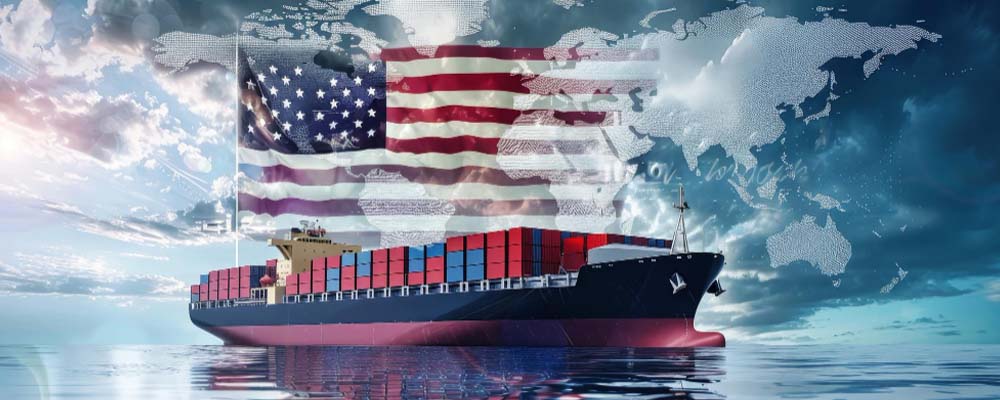In today’s globalized economy, exporting goods to the United States presents a significant opportunity for businesses looking to expand their reach. The USA remains one of the most lucrative markets, thanks to its robust economy, diverse consumer base, and advanced trade infrastructure. This comprehensive guide aims to provide freight forwarding companies, logistics providers, importers and exporters, and other industry-related professionals with valuable insights into the major ports in the USA, popular imports, and the strategies for efficient trade.
Why Export to the USA?
Exporting to the USA can be a game-changer for your business. The American market offers vast opportunities due to its size, purchasing power, and diverse consumer needs. Many foreign businesses find that entering the US market leads to increased revenue and brand recognition.
The USA’s economy is one of the strongest in the world, boasting high GDP and consumer spending rates. This means that American consumers have the financial ability to purchase a wide variety of goods, making it an ideal market for exporters. Additionally, the country’s commitment to free trade agreements and economic policies that favor international trade further enhances its attractiveness.
However, tapping into this market requires a deep understanding of its trade infrastructure and regulations. This guide will walk you through these critical elements, ensuring that you are well-prepared to succeed.
Understanding USA Trade Infrastructure
The United States has an extensive and sophisticated trade infrastructure that supports its status as a global trade hub. This infrastructure includes a network of well-maintained highways, railways, and airports that facilitate the efficient movement of goods across the country.
Ports play a crucial role in this infrastructure. They serve as the primary entry points for goods entering the country and are equipped with state-of-the-art facilities to handle large volumes of cargo. These ports are strategically located along the East, West, and Gulf coasts, providing access to different regions of the country.
In addition to physical infrastructure, the USA has advanced technological systems that streamline customs procedures and improve supply chain efficiency. Understanding how to leverage this infrastructure is key to successful exporting.
The Importance of USA Ports in Trade
Ports are the lifeblood of international trade, serving as the gateways through which goods enter and exit a country. In the USA, ports are particularly significant due to the sheer volume of trade they handle. Efficient port operations are critical to ensuring that goods are moved quickly and cost-effectively.
Major ports in the USA are equipped with advanced machinery and technology that facilitate the handling of large containers and bulk cargo. These ports also have extensive warehousing facilities, allowing for the temporary storage of goods before they are distributed further.
For exporters, understanding the operations and capabilities of these ports is essential. It allows you to choose the most suitable port for your needs, optimize your supply chain, and ensure timely delivery of goods to your customers.
Major Ports in the USA
Port of Los Angeles
The Port of Los Angeles is the busiest port in the United States and one of the largest in the world. Located on the West Coast, it handles a significant portion of the country’s imports, particularly from Asia. The port boasts extensive facilities, including numerous container terminals and advanced cargo-handling equipment, making it a key hub for international trade.
Port of New York and New Jersey
Situated on the East Coast, the Port of New York and New Jersey is another major gateway for international trade. This port is strategically positioned to serve the densely populated northeastern region of the USA. It offers a wide range of services, including container handling, bulk cargo operations, and extensive warehousing facilities.
Port of Houston
The Port of Houston is the leading port on the Gulf Coast and plays a vital role in the import and export of goods to and from Latin America. Known for its petrochemical facilities, the port also handles a diverse range of other cargoes. Its strategic location and robust infrastructure make it a crucial player in the USA’s trade network.
Popular Imports to the USA
The United States imports a wide variety of goods from around the world. Some of the most popular categories include electronics, machinery, vehicles, and apparel. These items are in high demand due to the country’s advanced technological landscape and consumer preferences.
Electronics
Products such as smartphones, computers, and home appliances are among the top imports. The USA is a leading market for the latest electronic gadgets, driving continuous demand for these products.
Machinery
Industrial and agricultural machinery are essential imports that support the USA’s manufacturing and farming sectors. These include everything from heavy machinery to specialized equipment used in various industries.
Apparel
Fashion and apparel are also significant imports. American consumers have a strong preference for diverse and trendy clothing options, making this sector a lucrative market for exporters.
Understanding these popular imports can help your business identify opportunities and tailor your offerings to meet the needs of the American market.
 Navigating USA Import Regulations
Navigating USA Import Regulations
Importing goods into the USA involves complying with a complex set of regulations. These regulations are designed to ensure the safety, quality, and legality of imported goods. Familiarizing yourself with these rules is crucial to avoid delays and penalties.
Customs and Border Protection (CBP)
The CBP is responsible for enforcing import regulations. This includes inspecting shipments, assessing duties, and ensuring compliance with federal laws. It is essential to work closely with customs brokers to facilitate smooth clearance of your goods.
Tariffs and Duties
Understanding the tariff schedule and duty rates applicable to your products is vital. These charges can have a substantial effect on your pricing and profitability. Make sure to classify your goods correctly and explore any available trade agreements that might reduce tariffs.
Compliance Requirements
Various federal agencies, such as the Food and Drug Administration (FDA) and the Environmental Protection Agency (EPA), have specific compliance requirements for different products. Ensure that your goods meet all applicable standards and obtain the necessary certifications.
Leveraging Technology for Efficient Trade
Technology plays a pivotal role in modernizing trade processes. By leveraging advanced digital tools, businesses can streamline operations, reduce costs, and enhance efficiency.
Automated Customs Clearance
Automated systems expedite the customs clearance process by reducing paperwork and minimizing human errors. Platforms like the Automated Commercial Environment (ACE) facilitate electronic submission of import documentation, speeding up the entire process.
Supply Chain Management Software
Advanced supply chain management software provides real-time visibility into inventory levels, shipment statuses, and logistics operations. These tools enable better decision-making and help you respond quickly to any disruptions.
Data Analytics
Data analytics tools offer valuable insights into trade patterns, market trends, and customer preferences. By analyzing this data, businesses can optimize their strategies and stay ahead of the competition.
Building Strong Partnerships
Building strong partnerships with key stakeholders is essential for successful trade with the USA. Collaborating with reliable partners can enhance your business’s capabilities and ensure smooth operations.
Freight Forwarders
Freight forwarders play a crucial role in managing the transportation and logistics of goods. Partnering with experienced freight forwarders ensures efficient movement of goods and compliance with regulations. Freight forwarders can provide valuable insights and support throughout the trade process.
Customs Brokers
Customs brokers are experts in navigating customs regulations and procedures. Collaborating with customs brokers ensures smooth and timely clearance of goods. Customs brokers can assist with documentation, compliance, and tariff classification, reducing the risk of delays and penalties.
Local Distributors
Partnering with local distributors helps exporters reach their target market effectively. Local distributors have a deep understanding of the market and can provide valuable market insights. They can also facilitate the distribution and marketing of products, ensuring a strong presence in the USA.
Understanding Cultural Differences
Cultural understanding is essential for successful international trade. Being aware of cultural nuances helps build stronger relationships with partners and customers in the USA. Americans value direct communication, so be clear and concise. Open and honest communication fosters trust and collaboration. Understanding American business etiquette is also crucial. Punctuality is highly valued, so be on time for meetings. Showing appreciation through gestures like thank-you notes can leave a positive impression. American consumers have diverse preferences, so conduct market research to understand their needs and tailor products and marketing strategies accordingly. Personalization and excellent customer service are highly appreciated.
Sustainable Trade Practices
Sustainability is increasingly important in international trade. Adopting sustainable practices benefits the environment, enhances brand reputation, and boosts competitiveness. Using eco-friendly packaging reduces your environmental footprint and appeals to conscious consumers. Consider biodegradable and recyclable materials. Ethically sourcing products, including fair labor and responsible raw material sourcing, builds customer trust. Communicate your commitment to sustainability. Implement measures like optimizing transportation routes and using energy-efficient technologies to reduce your carbon footprint. Consider offsetting emissions with carbon credits.
 Conclusion
Conclusion
Exporting to the USA offers immense opportunities for businesses seeking growth and expansion. By understanding the trade infrastructure, major ports, popular imports, and regulatory requirements, you can position your business for success in this lucrative market. Leveraging technology, building strong partnerships, and adopting sustainable practices further enhance your competitive edge.
Ready to take the next step? Explore our resources and connect with industry experts to refine your trade strategies.
Together, we can unlock the full potential of exporting to the USA!






 Navigating USA Import Regulations
Navigating USA Import Regulations Conclusion
Conclusion



